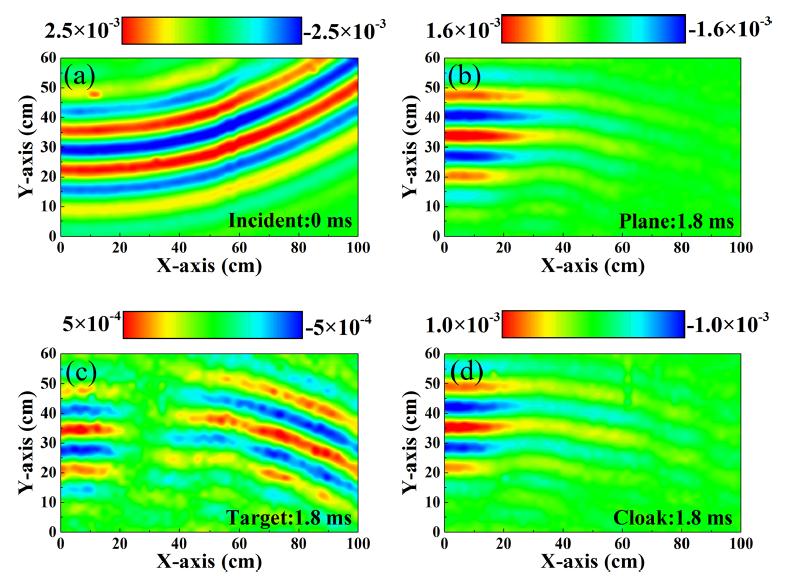Cloaking is one of the most eye-catching technologies in sci-fi movies. In two 2018 Marvel films, Black Panther and Avengers: Infinity War, Black Panther conceals his country Wakanda, a technologically advanced African nation, from the outside world with the metal vibranium.
However, in the real world, if you want to hide something, you need to deceive not only the eyes, but also the ears, especially in the underwater environment.
Recently, a research team led by Prof. YANG Jun from the Institute of Acoustics (IOA) of the Chinese Academy of Sciences designed and fabricated a 3D underwater acoustic carpet cloak (UACC) using transformation acoustics.

Figure 1. Model and photograph of the 3D underwater acoustic carpet cloak composed of over 700 steel strips. Objects can hide under the cloak without being detected by sonar. (Image by IOA)
The research was published online in Applied Physics Letters on June 1.
Like a shield, the carpet cloak is a material shell that can reflect waves as if the waves were reflecting off a planar surface. Hence, the cloaked target becomes undetectable to underwater detection instruments like sonar.

Figure 2. The 3D UACC looks like a shield from the vertical view, and a pyramid from the side view. (Image by IOA)
Using transformation acoustics, the research team first finished the 2D underwater acoustic carpet cloak with metamaterial last year (Scientific Reports,April 6,2017). However, this structure works only in two dimensions, and becomes immediately detectable when a third dimension is introduced.
To solve this problem, YANG Jun and his IOA team combined transformation acoustics with a reasonable scaling factor, worked out the parameters, and redesigned the unit cell of 2D cloak. They designed the 3D underwater acoustic carpet cloak and then proposed a fabrication and assembly method to manufacture it. The 3D cloak can hide an object from top to bottom and deal with complex situations, such as acoustic detection in all directions.
The 3D underwater acoustic carpet cloak is a pyramid comprising eight triangular pyramids; each triangular pyramid is composed of 92 steel strips with a rectangle lattice, similar to a wafer biscuit.
More vividly, if we remove the core from a big solid pyramid, we can hide something safely in the hollow space left.
“To make a 3D underwater acoustic carpet cloak, researchers needed to construct the structure with 2D period, survey the influence of the unit cell’s resonance, examine the camouflage effect at the ridge of the sample, and other problems. In addition, the fabrication and assembly of the 3D device required more elaborate design. The extension of the UACC from 2D to 3D represents important progress in applied physics,” said YANG.
In experimental tests, a short Gaussian pulse propagated towards the target covered with the carpet cloak, and the waves backscattered toward their origin. The cloaked object successfully mimicked the reflecting surface and was undetectable by sound detection. Meanwhile, the measured acoustic pressure fields from the vertical view demonstrated the effectiveness of the designed 3D structure in every direction.

Figure 3. Measured acoustic pressure fields. (a) The incident pressure field at 0 ms. (b)–(d) The scattered pressure fields at 1.8 ms from the soft plane (b), the soft target (c), and the cloaked soft target (d), respectively. (Image by IOA)
“As the next step, we will try to make the 3D underwater acoustic carpet cloak smaller and lighter.” said YANG.
Funding for this research came from the National Natural Science Foundation of China (Grant No.11304351, 1177021304), the Youth Innovation Promotion Association of CAS (Grant No. 2017029), and the IACAS Young Elite Researcher Project (Grant No. QNYC201719).
Prof. YANG Jun and Dr. JIA Han led the research team from the Institute of Acoustics (IOA) of the Chinese Academy of Sciences. Prof. YANG Jun engages in research on sound, vibration and signal processing, and especially sound field control and array signal processing. They also work on other devices based on metamaterial in order to manipulate the propagation of sound waves.
Reference:
BI Yafeng, JIA Han, SUN Zhaoyong, YANG Yuzhen, ZHAO Han, YANG Jun. Experimental Demonstration of Three-dimensional Broadband Underwater Acoustic Carpet Cloak. Applied Physics Letters( Epub 2018 June 01).DOI:10.1063/1.5026199.
Contact:
WANG Rongquan
Institute of Acoustics, Chinese Academy of Sciences, 100190 Beijing, China
E-mail: wangrongquan@mail.ioa.ac.cn


